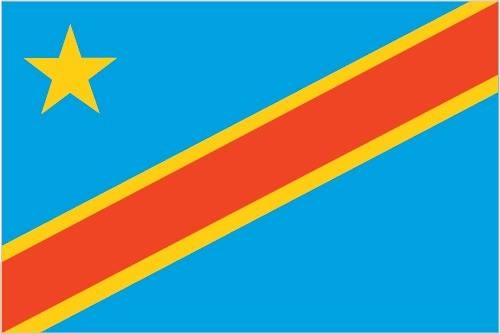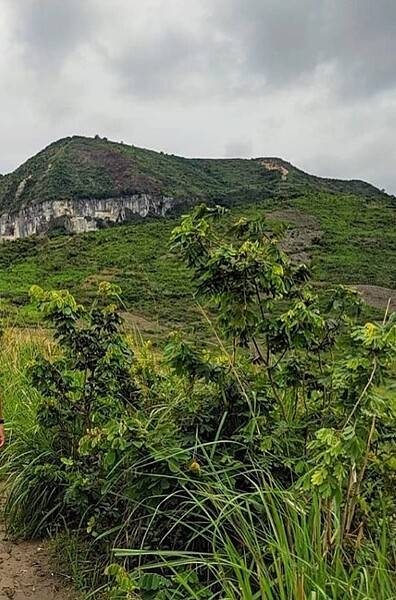190 Democratic Republic of the Congo

Sky blue field divided diagonally from the lower hoist corner to upper fly corner by a red stripe bordered by two narrow yellow stripes. A yellow, five-pointed star appears in the upper hoist corner. Blue represents peace and hope, red the blood of the country’s martyrs, and yellow the country’s wealth and prosperity. The star symbolizes unity and the brilliant future for the country.
Flag courtesy of the CIA World Factbook

Map courtesy of the CIA World Factbook

Mount Mangengenge is located southeast of Kinshasa and overlooks the capital city; it is part of the Crystal Mountains range. Mount Mangengenge is a pilgrimage site for many Congolese. The path of ascent is punctuated with crucifix sculptures and it has a large cross at the summit.
Photo courtesy of the CIA World Factbook
Government
According to Britannica, Congo’s civil war (1998–2003) was essentially ended by a power-sharing agreement that created the transitional constitution of 2003, which provided for a transitional government that consisted of representatives from various rebel groups, the previous government, the political opposition, and civil organizations. A new, formal constitution, approved by referendum in 2005 and promulgated in 2006, significantly devolved power to provincial administrations. Under it, the president is to be elected to no more than two five-year terms and must share power with the prime minister, who is to be named from the legislature’s largest party. The legislature is bicameral, consisting of the National Assembly and the Senate.
For administrative purposes, the country has long been divided into a varying number of regions or provinces. After the overthrow of Mobutu’s regime in 1997, the country was organized into 10 provinces and the ville (city) of Kinshasa, the latter being the equivalent of a federal district. The 2006 constitution provided for an increase in the number of provinces from 10 to 26 (including Kinshasa), though the new provincial structure was not implemented until 2015. The provinces are presided over by governors.
For many years, the Supreme Court (located in Kinshasa) and the Courts of Appeal stood at the centre of Congo’s judicial system, but, after the promulgation of the 2006 constitution, they were slated to be superseded by the new judicial structure. The 2006 constitution provides for an independent judiciary consisting of the Constitutional Court, the Court of Cassation, the Council of State (a federal administrative court), the Military High Court, and lower courts and tribunals throughout the country.
Civil Aviation Authority of the DRC
The Civil Aviation Authority of the DRC, “AAC/RDC” for short,
is a public administrative institution with legal personality and administrative and financial autonomy. Its founding act is Decree No. 011/29 of 10/06/2011 establishing the statutes of a public institution called “AAC/RDC”.
The AAC/DRC is the Government’s advisor on civil aviation. As such, without prejudice to the legal and regulatory provisions in force, it is responsible in particular for:
1. assisting the Government in defining and implementing national aeronautical policy, taking into account the country’s needs and up-to-date international standards and conventions;
2. implementing the Congolese State’s aviation policy;
3. proposing to the Government:
– national airport security and facilitation programs;
– the national civil aviation security program;
– and the national civil aviation disaster and crisis management program;
4. administering, regulating and supervising civil aviation safety and security;
5. guiding and coordinating all civil aviation activities with other relevant administrations in the implementation of the State’s civil aviation policy;
6. to issue, update and enforce technical regulations relating to aerodromes, aircraft operations, aircraft airworthiness, air navigation, aeronautical personnel, air transport, general aviation, aeronautical meteorology as well as economic regulations, concerning the operation of commercial air services and general aviation;
7. to ensure the implementation of international legal instruments ratified by the Democratic Republic of Congo in the field of civil aviation;
8. to ensure the promotion of civil aviation in the Democratic Republic of Congo;
9. to liaise with international organizations in matters relating to civil aviation;
10. to issue, renew, suspend or withdraw:
– approvals for the provision of ground handling services to air carriers and authorized service providers;
– approvals for air cargo agencies, aircraft and ground handling companies,catering and any air service provider operating on the airport platforms of the Democratic Republic of Congo;
– any approval, permit, certificate, and any authorization or license of aeronautical personnel provided for by the regulations;
– authorizations provided for the transport of dangerous goods;
– authorizations to operate private air services and aerial work;
– authorizations for non-scheduled flights;
– air carrier certificates;
– airworthiness certificates, radio station licenses and nuisance certificates;
– aerodrome and air navigation facility certificates.
11. to ensure the continuous monitoring of the technical activities of any natural or legal person established in the Democratic Republic of Congo and authorized to work in the civil aviation sector
Airspace
SkyVector – Google Maps – ADS-B Exchange
ICAO countries publish an Aeronautical Information Publication (AIP). This document is divided into three parts: General (GEN), En Route (ENR) and Aerodromes (AD). ENR 1.4 details the types of airspace classes they chose to adopt from classes A through G.
Drone Regulations
Advanced Air Mobility (AAM) Regulations & Policies
None found by the author.
However, should you, the reader, happen to stumble across something to the contrary, please email the author at FISHE5CA@erau.edu and you may be mentioned in the ACKNOWLEDGEMENTS section of this book by way of thanks for contributing to this free eBook!
Advanced Air Mobility (AAM) News
None found by the author.
However, should you, the reader, happen to stumble across something to the contrary, please email the author at FISHE5CA@erau.edu and you may be mentioned in the ACKNOWLEDGEMENTS section of this book by way of thanks for contributing to this free eBook!
Short Essay Questions
Scenario-Based Question
You have been hired by a Drone Startup Company. Your boss has immediately assigned this job to you.
They need you to prepare a one-page memo detailing the legalities of using a drone to film in Kinshasa, pictured above.
They need you to mention any national laws and local ordinances.
They specifically want to know what airspace (insert pictures) you will be operating in and whether or not you need an airspace authorization.
Does it matter whether or not you are a citizen of the country?
Lastly, there is a bonus for you if, as you scroll through this chapter, you find any typos or broken links!
Short Essay Questions
- What are the drone categories?
- How is registration addressed?
- How is remote ID addressed?
- What are the model aircraft rules?
- What are the commercial drone rules?
- Are there waivers or exemptions to the rules? If so, for what?
- Would you share a link to an interactive airspace map?
- How is BVLOS addressed?
- How can you fly drones at night?
- How can you fly drones over people?
- Where do you find drone NOTAMs?
- What are the rules for drone maintenance?
- What are the rules for an SMS program?
- What are some unique rules not mentioned above?
- What are the C-UAS rules?
- What are the AAM rules?

